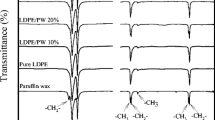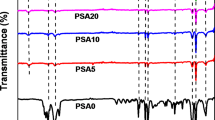Abstract
Polylactic acid (PLA) is a hydrolytically degradable aliphatic polyester, and water vapor permeability may have a significant influence on the rate of degradation. A method is devised to use bags prepared from PLA films and filled with molecular sieves to determine the water vapor permeability in the polymer, its copolymers with caprolactone, and blends with polyethylene glycol. The “solution-diffusion” model is used to determine the permeability parameters. These include the solubility coefficient,S, a measure of the equilibrium water concentration available for hydrolysis and the diffusion coefficient,D, which characterizes the rate of water vapor diffusion into the film under specific conditions. Values ofS andD at 50‡C and 90% relative humidity ranged from 400 × 10-6 to 1000 × 10-6 cm3 (STP)/(cm3 Pa) and 0.20 × 10-6 to 1.0 × 10-6 cm2/s, respectively. TheS andD coefficients were also measured at 20 and 40‡C and compared to those of other polymers. The degree of crystallinity was found to have little influence on the measured permeability parameters. The heat of sorption, δHS, and the activation energy of diffusion, ED, were used to show that the permeability process is best described by the “water cluster” model for hydrophobic polymers. Finally, the diffusion coefficient is used to compare the rate of water diffusion to the rate of water consumption by ester hydrolysis. Results indicate that hydrolytic degradation of PLA is reaction-controlled.
Similar content being viewed by others
References
A. C. Albertsson and S. Karlsson (1994)Chem. Technol. Biodegrad. Polym. 23, 7.
K. P. Andriano, T. Pohjonen, and P. Tomali (1994)J. Appl. Biomater. 5, 133.
R. Bodmeier, K. Oh, and H. Chen (1989)Int. J. Pharm. 51, 1.
P. Cerrai, L. Tricoli, G. D. Guerra, R. Sbrabati Del Guerra, M. G. Cascone, and P. Guisti (1994)J. Mater. Sci. Mater. Med. 5, 308.
E. Chiellini and R. Solaro (1993)Chemtech. July, 29.
M. Coffin and McGinity (1993)J. Pharm. Res. 9(2), 200.
L. Fambri, A. Pegiretti, M. Mazzurana, and C. Migliaresi (1994)J. Mater. Sci. Mater. Med. 5, 679.
R. Kenley, M. O. Lee, T. Mahoney, and L. Sanders (1987).Macromolecules 20, 2398.
S. Li, H. Garreau, and M. Vert (1990A)J. Mater. Sci. Mater. Med. 1, 123.
G. Rafler and M. Jobmann (1994)Drugs Made Germany 37(3), 83.
M. Therin, P. Christel, S. Li, H. Garreau, and M. Vert (1992)Biomaterials 13(9), 594.
M. Vert, S. Li, and H. Garreau (1994)J. Biomater. Sci. Polym. Edu. 6, 639.
E. Lipinsky and R. G. Sinclair (1986)Chem. Eng. Prog. Aug., 26.
J. M. Mayer and D. L. Kaplan (1994)TRIP 2(7), 227.
G. Swift (1990)Agr. Synth. Polym. Mar., 2.
J. A. Tamada and R. Langer (1993)Proc. Natl. Acad. Sci. USA 90, 552.
C. Yue, V. Dave, R. Gross, and S. P. McCarthy (1995)Polym. Preprints 36(1), 418.
S. P. Sawan and J. J. Barry (1988)Polym. Preprints 29(1), 299.
A. Andrady (1994)J.M.S. Rev. Macromol. Chem. Phys. C34(1), 25.
S. Li, H. Garreau, and M. Vert (1990).J. Mater. Sci. Mater. Med. 1, 198.
D. Cohn and H. Younes (1988).J. Biomed. Mater. Res. 22, 993.
X. Feng, C. Song, and W. Chen (1983)J. Polym. Sci. Polym. Lett. Ed. 21, 593.
C. H. Holten (1971)Lactic Acid, Verlag Chemie, Berlin.
S. Li and M. Vert (1994)Macromolecules 27, 3107.
N. S. Mason, C. S. Miles, and R. E. Sparks (1981)Polym. Sci. Technol. 14, 279.
W. P. Hsu, P. Y. Lo, A. S. Myerson, and T. K. Kwei (1992).AIChE J. 38(9), 1481.
J. Brandup and E. H. Immergut (1988)Polymer Handbook, Wiley Interscience, New York.
K. H. Lam, P. Nieuwenhuis, I. Molenaar, H. Esselbrugge, J. Feijen, P. J. Dijkstra, and J. M. Schakenraad (1994)J. Mater. Sci. 5(4), 181.
U. Siemann (1985)Thermochim. Acta 85, 513.
E. A. Schmitt, D. R. Flanagan, and R. J. Lindhardt (1994)Macromolecules 27, 743.
C. Pitt, Y. Cha, S. Shah, and K. Zhu (1992)J. Control. Release 19, 189.
D. Cohn, H. Younes, and G. Maron (1987)Polymer 28, 2018.
G. E. Zaikov, A. L. Iordanskii, and V. S. Markin (1988)New Concepts in Polymer Science. Diffusion of Electrolytes in Polymers, Elsevier Science, Amsterdam.
D. W. Van Krevelen (1990)Properties of Polymers, Elsevier Science, Amsterdam.
W. P. Hsu, R. J. Li, A. S. Myerson, and T. K. Kwei (1993)Polymer 34(3), 597.
P. M. Jacobs and F. R. Jones (1989)J. Mater. Sci. 24, 2331.
P. M. Jacobs and F. R. Jones (1989)J. Mater. Sci. 24, 2343.
P. M. Jacobs and F. R. Jones (1990)J. Mater. Sci. 25, 2471.
G. L. Siparsky (1995)The Degradation of Poly-(Lactic Acid)and Its Copolymers with Poly-(∃-caprolactone): Hydrolysis and Permeability, Colorado School of Mines, Golden, CO.
CRC Handbook of Chemistry and Physics, 55th ed., CRC Press, Cleveland, OH, 1974–1975.
K. A. Lokhandwala, S. M. Nadakatti, and S. A. Stern (1995)J. Polym. Sci. Part B Polym. Phys. 33, 965.
X. Zhang, U. Wyss, D. Pichora, and M. Goosen (1994)J. Bioac. Compat. Polym. 9, 80.
Author information
Authors and Affiliations
Rights and permissions
About this article
Cite this article
Siparsky, G.L., Voorhees, K.J., Dorgan, J.R. et al. Water transport in polylactic acid (PLA), PLA/ polycaprolactone copolymers, and PLA/polyethylene glycol blends. J Environ Polym Degr 5, 125–136 (1997). https://doi.org/10.1007/BF02763656
Issue Date:
DOI: https://doi.org/10.1007/BF02763656




